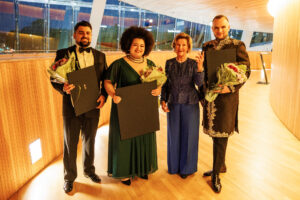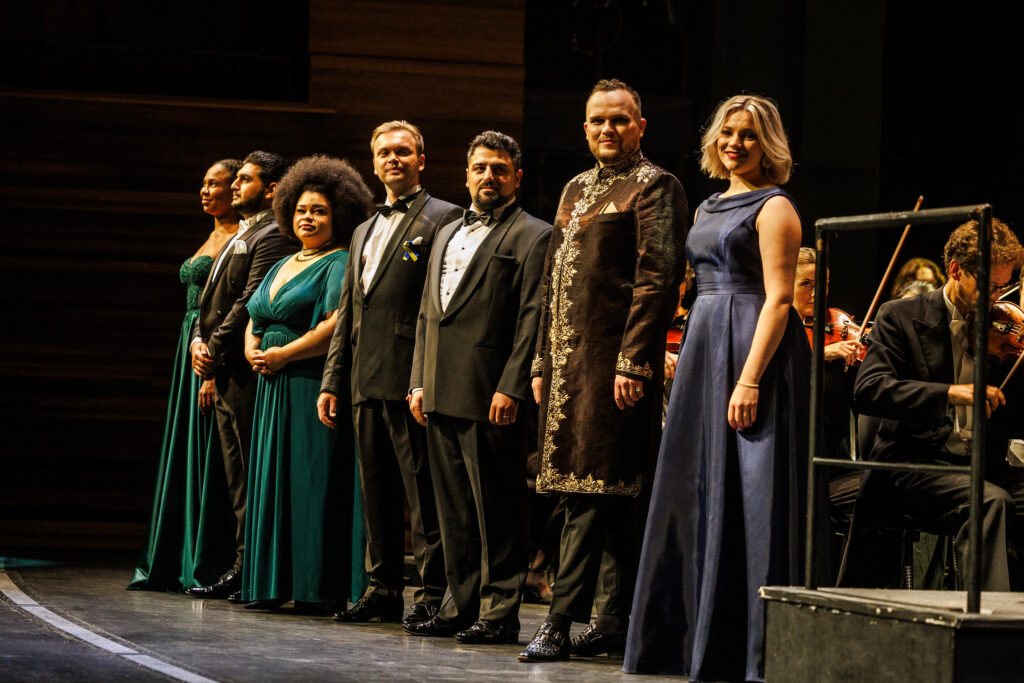
Winning in Norway – The Experience of Taking in the Final of the 2023 Queen Sonja Singing Competition
By David SalazarFinals for singing competitions are an interesting experience to cover. On one hand, everyone on stage is a winner. In the case of the 2023 edition of the Queen Sonja Singing Competition, the six singers who took the stage on August 26 were picked from an overall pool of 521 contestants from around the world; not mention that the competition itself puts a limit of a maximum number of singers from any country that it allows to progress through the competition. So regardless of who took home first, second, or third, they were already in an enviable position.
But of course, it is a competition, and the finalists all had something at stake. Perhaps nothing to lose, but undeniably something to win. First off, 50,000 euros. And second of all, the prestige and career stepping-stone that comes with getting your name in the history books alongside such past winners as Maria Motolygina, Kristina Mkhitaryan, Mario Bahg, Sergey Kaydalov, and one Lise Davidsen, who happened to be the host of the 2023 finals. Not to mention, making a major impression on the myriad of jury members including Randi Stene (Director of Opera at the Norwegian National Opera and Ballet), Samuel Gelber (Director of Artistic Planning at the Washington National Opera), Michael Heaston (Assistant General Manager of the Metropolitan Opera), Stefan Herheim (Opera Director at the Theater an der Wien), Sophie de Lint (Director the Dutch National Opera), Annette Weber (Director of the Opernhaus Zürich), and Pal Christian Moe (Administrator and Casting Adviser).
In that light, the pressure is on and the event, very much a sporting one as it is an artistic one, takes on a unique experience and tension. Opera is all about the most intense of drama, but a vocal competition final, ups the ante considerably. Every moment counts and is magnified.
Setting the Stage
This year’s final took place at the Norwegian National Opera. The new building was opened in 2008 after a decade of development. Outside it is a magnificent and imposing structure made of over 36,000 marble stones from Italy. The inclined structure allows anyone in the area to climb to the top and get a panoramic view of Oslo’s port area. The space was built with the public in mind and in the winter, people can even snowboard down the side of the opera house. Moreover, the space is so vast that at one point, the company was able to seat 5,000 people outside the house to view a live stream performance of “Carmen” taking place inside the house. For context, the Met Opera will simulcast its opening night performance of “Dead Man Walking” to just north of 2,000 people in all of Times Square.
The indoor of the theater features an equally imposing wooden structure made of oak from Germany and Ukraine. That wooden structure extends to the inside of the hall where the wooden panels wrap around the entire space. It was described to press and media visiting the opera house that the intention was to feel like you were “inside an instrument.” And the acoustics bear this out. Instead of a wall of sound and mushy textures one might hear in other theaters, the sound from the stage comes through with clarity and fine detail. So much so that at times, brass sounds could come across a bit aggressively. But it also allowed for softer and more gentle moments from singers and the orchestra to connect with greater intimacy.
Towering over the entire hall is a circular chandelier that is 50 square meters and features over 5,8000 handcarved crystals, the largest in all of Norway. And despite weighing eight tons, it’s also an acoustic reflector.
Contestants were in Norway for two weeks as they made their way through the rounds and coachings. The back of the house is just as impressive behind the scenes as it is for the audience engaging with the outward facing spaces. Boasting over 1,000 rooms, “The Factory,” as it is referred to features a central garden through which light can enter the workplace (a legal requirement for all workplaces in Norway). Right behind the stage is a massive space that can store up to five productions at the same time and even includes two separate theaters that, with the use of built-in sound-proof walls, can actually allow for three separate performances at once (or a performance and rehearsals). On this occasion, the space contained its “Così fan tutte” production, its “Sleeping Beauty,” a new “La Traviata” that premieres in September, and the upcoming production of “Fram.”
One final and interesting piece of information about the house is that there are no private boxes. When the Queen comes to a performance, she sits in the front row of the first balcony. But anyone can purchase seats around her. That was the case during the final, where the Queen’s arrival following each of the intervals was met with a fanfare from the orchestra and all the audience members standing to greet her.
The Russian Elephant in the Room
The performance itself featured James Gaffigan leading the Norwegian Opera Orchestra with the Polonaise from Tchaikovsky’s “Eugene Onegin.” I have to bring this up because of one of the big stories in the lead up to the competition final. A few months back it was announced that it would not allow Russian or Belarussian singers to compete in this year’s edition. It led to some artists, including mezzo-soprano Amria Ostroukhova speaking out against the rules. Perhaps the most contentious situation arose when Anastasiya Tartorkina was eliminated from the competition, despite possessing German citizenship. The reason? She also possessed Russian citizenship.
Adding to the intrigue is the fact that Russians and Belarussians usually do exceedingly well at the competition. Since 2013, three of the competition’s first place winners were Russian (Kristina Mkhitaryan in 2013, Sergey Kaydalov in 2019, and Maria Motolygina in 2021); throw in the fact that Alexander Roslavets took home third place in 2017 and in all of these competition, save for the 2015 edition, a Russian / Belarussian has managed to place in the top three each time.
In a media gathering prior to the event, the competition’s Executive Director Lars Hallvard Flaeten stated that the organization felt that it was important to make this decision due to Russia’s ongoing invasion of Ukraine.
“We can debate [the decision]. We have been criticized for it. But we stand firmly with the people of Ukraine,” Flaeten said.
It was interesting however that the performance featured, not one, or two, but three Russian pieces (all by Tchaikovsky) out of the 14 that were performed on the night. By contrast of the remaining repertory performed, five were in Italian (including one piece by Mozart and two by Händel, neither is technically an Italian composer), two were in English (three if you include the fact that eventual winner Jasmine White sang “Iris Hence Away” twice on the night), one in Finnish, two were in French, and one was in German (with an orchestral interlude from “Tannhäuser” bringing the finalists to the stage at the very end of the performance). I bring this up because the finalists submitted a list of repertoire in different languages to the jury and it was the jury members that selected the program for the evening. The fact that Russian repertoire was second in representation was, perhaps, a unique and notable coincidence.

Photo credit: Per Ole Hagen
The Finalists
The finalists included three baritones – Armenians Aksel Daveyan and Navasard Hakobyan, as well as Ukrainian Vladyslav Tlushch; Swedish mezzo-soprano Rebecka Wallroth; German countertenor Nils Wanderer; and U.S. contralto Jasmin White.
Each singer got a chance to sing one aria in the first segment and then a second one after the interval. I’m not going to deep dive into the singers’ performances or pass judgment on them, but what was noticeable was the difference between the two halves. There was some tension in that first half with more than a few singers taking some time to warm up. Perhaps it was the repertory choices or perhaps the nerves. Perhaps both of them and a lot more. The second half was a different beast all together with everyone looking looser and more relaxed on stage. I obviously have no idea what the judges were thinking, but based on how the performances caught fire in the second half, it’s my impression that the competition was likely won in that first segment.
In the end, White took home the top prize with Daveyan coming in second, and Wanderer the one to take third place. White performed “Iris Hence Away” from “Semele” in the first half and then took on Erda’s “Weiche, Wotan! Weiche!” for her second selection. When asked during the press meeting what the jurors were looking for in the finalists, Flaeton said what most people would “the complete package.” He noted that opera was an increasingly visual medium and added that, given this fact, the jury was comprised of directors and casting directors instead of singers. So, you knew that the artist who delivered on “the complete package,” a combination of vocal and dramatic potency was going to dominate. That sentiment was echoed prior to the announcement of the winners by jury leader Randi Stene, who told the audience that “It has been extremely close. So, we have been looking for a winner who has the complete package.”
And no other singer managed that feat with the same commitment as White did. The Oregon-native was fierce and poised in both pieces, her powerful voice cutting clearly into the hall with clarity of sound and diction. She might have been standing in front of an orchestra, but as an audience member, you could feel the scenes she was inhabiting. The other singers in the competition all managed their own immersive moments, but no one quite managed to sustain you in their dramatic world quite like White did.
Daveyan sang “Kto mozhet sravnit’sia” from “Iolanta” and “Avant quitter ces lieux” from “Faust,” both allowing the baritone to display his elegant legato line and phrasing that resonated nicely in the space. The same held true for Wanderer, who, in my view got a bit of a short-end of the stick with “This Says The Boy” from “Written on Skin,” an atmospheric piece that was elegantly delivered by the countertenor, but felt too brief to make any major impression. However, Wanderer got ample time to make his mark with “Stille amare” from “Tolomeo,” showcasing a resonant and potent sound and strong dramatic sensibility.
From the other soloists, Hakobyan sang “Cruda funesta smania” from “Lucia di Lammermoor” and “Ja vas lyublyu” from “Pique Dame,” showcasing a gentle timbre and fluid line. Wallroth, the youngest of the crew at just 23, displayed solid technical control in “Parto, parto” from “La Clemenza di Tito,” and a flowing legato in “Flickan kom ifran sin älsklings möte” by Sibelius. Finally, Tlushch sang with delicacy and warmth in “Or dove fuggio io mai?… Ah per sempre” from “I Puritani” and brought down the house with an electrifying rendition of “Ò vin, dissipe la tristesse” from “Hamlet.”
Alongside them, Gaffigan proved a smooth and receptive collaborator, the orchestra was extremely receptive and responsive to the soloists. There were some moments where the conductor was a bit overzealous in how far he pushed the ensemble (especially in the Bel Canto arias where the texture felt a bit thick and hence presented a unique challenge to the singers). But for the night, the Norwegian Opera Orchestra was very much a vibrant participant in the proceedings.
Also, a highlight was the participation of soprano Lise Davidsen, who won the first prize back in 2015. Despite a minor trip up as she walked on stage, the soprano was energetic and captivating throughout the night as she introduced the participants and their arias.


